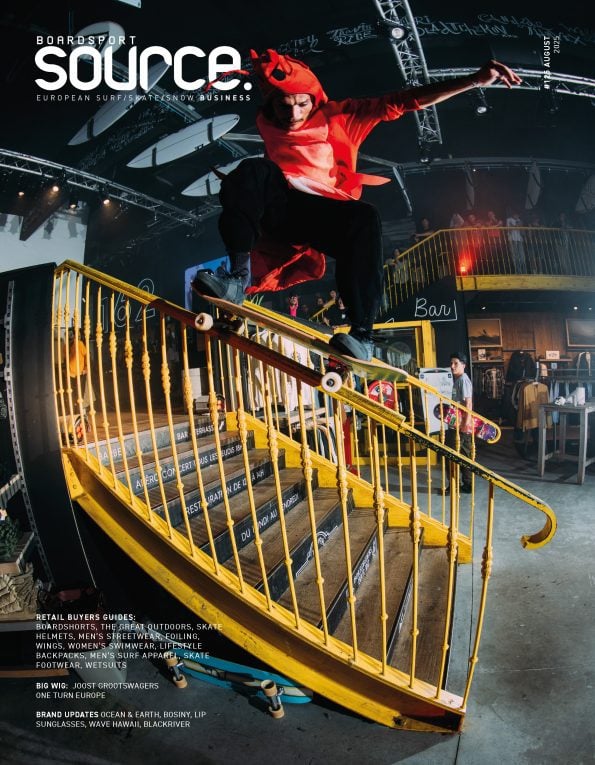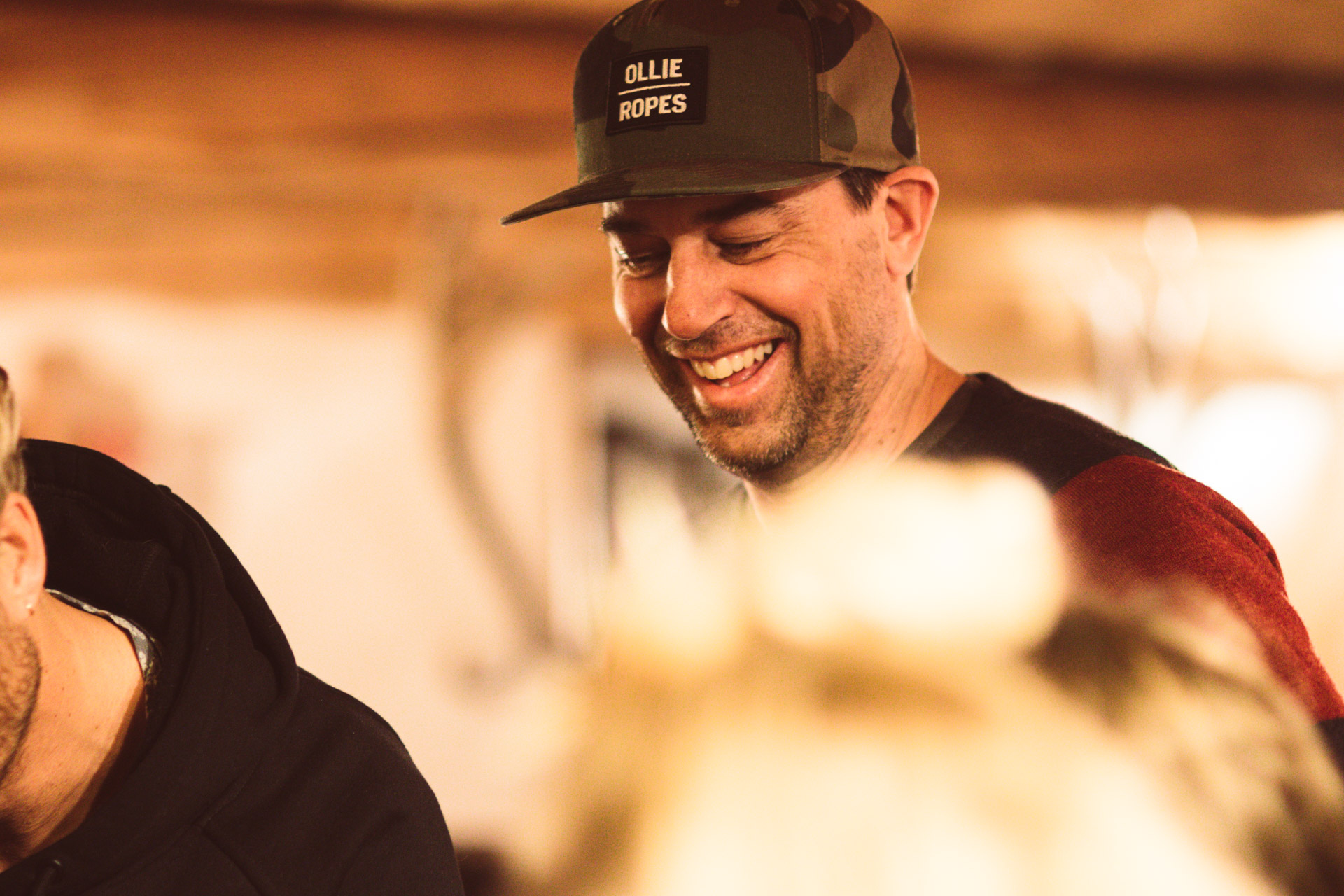
Rome Snowboards’ Josh Reid On His 35+ Year Love Affair With Snowboarding
Back in March SOURCE spent two days at the Rome Lodge, Sestriere (Italy) shredding, checking out next season’s gear, drinking Genepy and hanging out with Rome staff and endemic snow media.
Last month we ran our One Eyed Monster gallery and interview with Rome head honcho Josh Reid summarising the Lodge, which you can read here.
Anyone who’s had the pleasure of chatting with Josh will know he’s one of the most down to earth and mellow guys in snowboarding, and our chat slowly unravelled into a fantastic history of Josh’s life and love affair with snowboarding.
Below is the second in our two-part interview with Josh, where he starts off with his first experience of standing sideways on snow, early skate days and takes us through his time in the Peace Corps in Sri Lanka, testing Burton prototypes in New Zealand and right up to starting Rome SDS with Co-Founder Paul Maravetz in 2001.
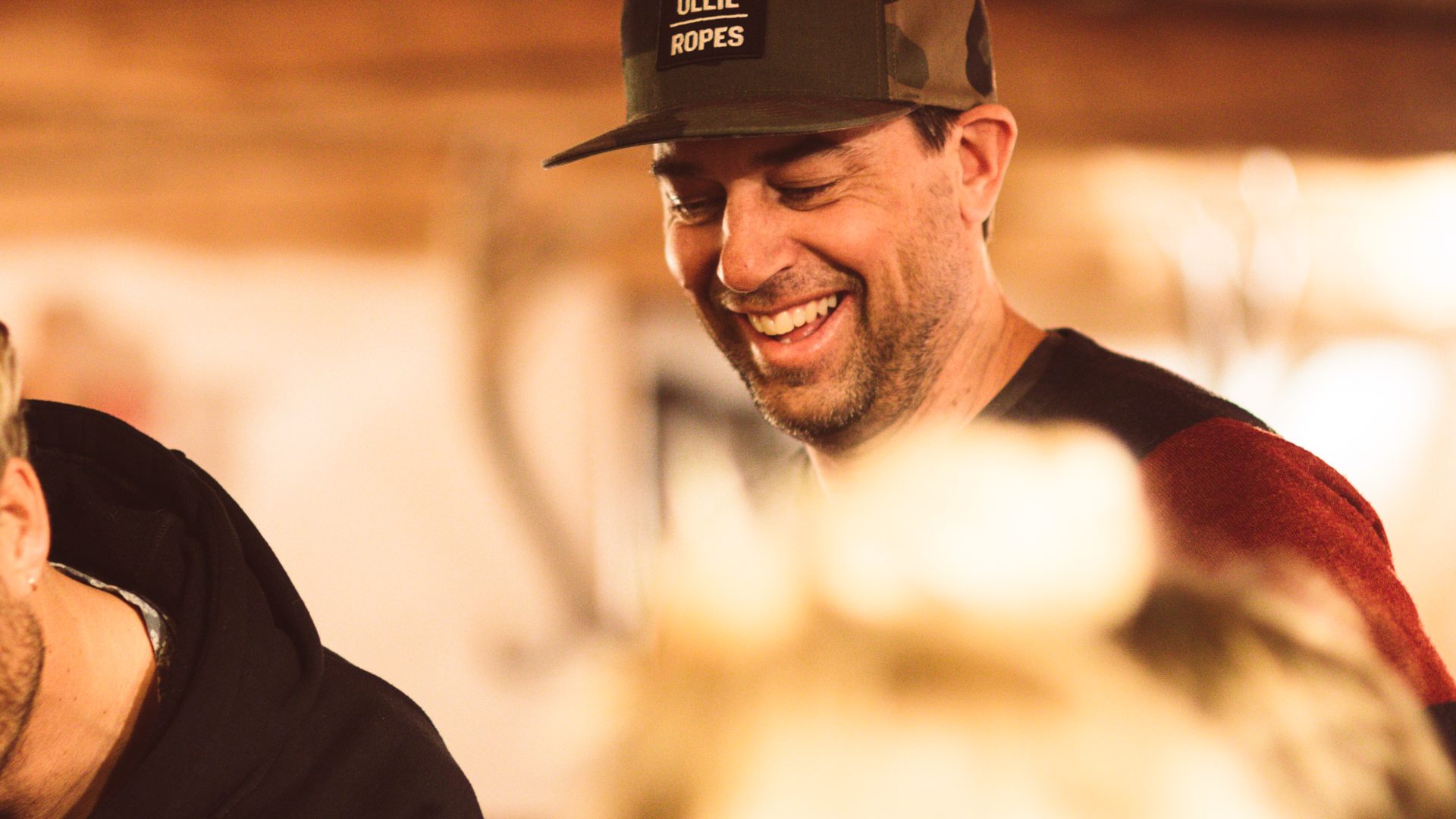
Rome Co-Founder Josh Reid with downtime in the Lodge. Photo Tom Greenhill
Let’s hear about your history in snowboarding. When did you start snowboarding?
It depends on what you call a snowboard. I’m of the opinion that if you accept the date of 1977 as the start date of a certain snowboard company, then you have to accept that the Snurfer is a snowboard, because for the first four or five years of that company, all they did was make Snurfers.
I had a Snurfer in the early 80s. 1980 or 1981, when I was 13. Leading up to that point in time I was a skateboarder in the 70s.
Do you still skate now?
I still skate a bit, not a ton, but I skate mini ramp. In the 70s I was way into skateboarding and I asked Pat Bridges from Snowboarder Mag to help me find this magazine once, because the mag goes back to how I got into snowboarding. Skateboarder Magazine, the first version of it from the late 70s, had a skater named Lonnie Toft and in one issue of Skateboarder there was a story about him going to Mammoth and he went snowboarding on one of those SIMS boards where there was his own skateboard patched to the yellow plastic boat type thing, and he was going off a five foot rock. I had step-brothers from New Mexico who were skiers and I’d skied a couple of times through them but I sucked at it. But when I saw those pictures of someone on snow with a board, I thought “that’s what I wanna do! I don’t wanna go with my dick and toes facing forward.”
My father was ridiculous with wood – he could do anything with wood, and I go to him with a picture of a Burton Backhill. I asked him if he could make me a board like this Burton Backhill thing – I was about 13 at the time – and he said “yeah sure, I’ll create a steam box, I’ll steam the plywood and bend it.” And then I was just dreaming! It was going to be amazing! And then Christmas day comes along and he tells me to go and look under my bed for my present. But I pulled it out and it was a fucking Snurfer! He’d bought me a Snurfer and it was six inches wide and there was me thinking I was getting this custom built Burton Backhill, but instead I had this!
So I used this for a couple of years, hiking up hills and sledding but it didn’t really work so great.
Four years later or so and skateboarding had died, but I got back into it with a friend. We’re talking the death years of skateboarding, like 82/83. Before I got a big Duane Peters Santa Cruz skateboard, my dad and I did make me a couple of boards when I was getting back into it, but then this bike shop in town started selling skateboards and it was where got the Santa Cruz Duane Peters. We were doing really rudimentary skateboarding – there were no ramps around in 1984. And then I became aware that Burton was selling snowboards with edges for the first time ever.
And do you remember how you heard about that?
I don’t know, it was probably at that bike store. My parents got divorced, but I was pretty good at lobbying them to collaborate, so I lobbied the two of them to pitch in and buy me a (Burton) Performer Elite 140 and I just started riding it on hills around town. As far as I knew no ski areas allowed snowboarding.
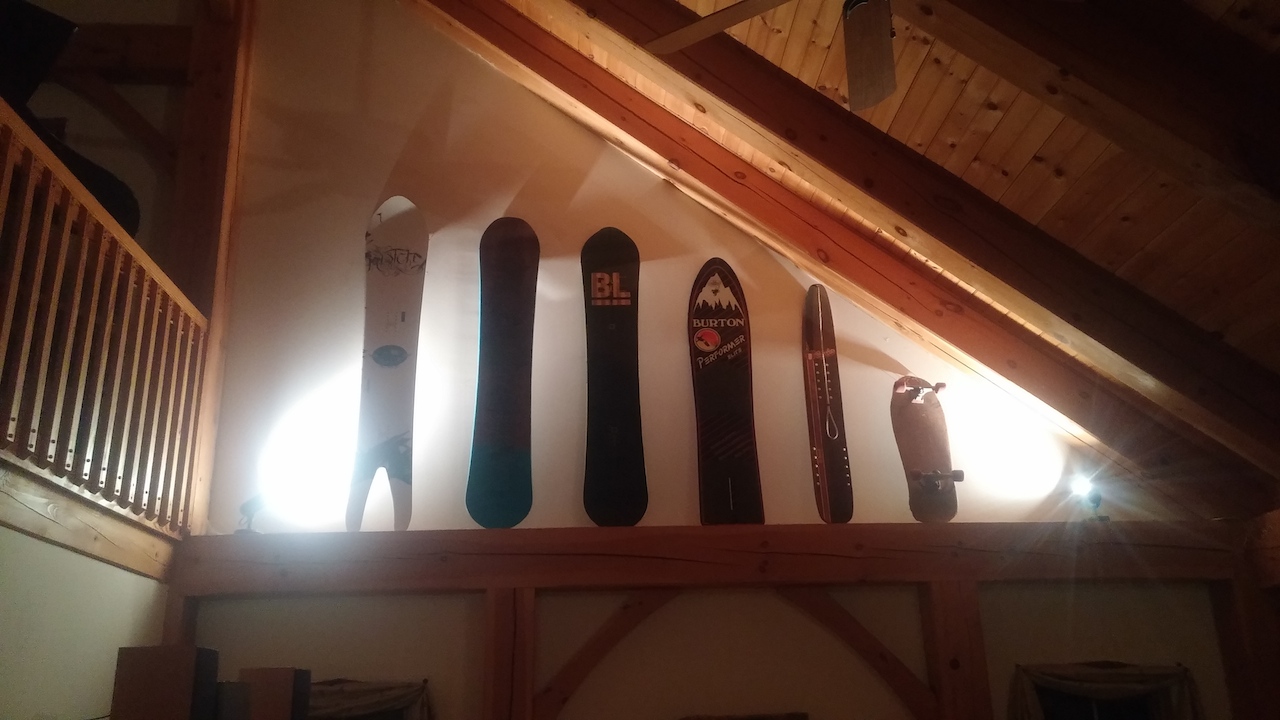
Josh’s quiver at home from over the year. Performer Elite 140 middle right
I think Stratton might have but I didn’t know that and the next year I went to university in Vermont and I bring the thing with me and hike up a couple of hills and do that. During Spring Break my brother came to visit and I’d heard these rumours that a ski area up near the (Canadian) border in Jay Peak didn’t have a policy against anything – you could do anything you wanted, you could even bring a sled on the mountain. Meaning I could bring a snowboard on the mountain and on a lift, so I wouldn’t have to go hiking each time I wanted to snowboard. So I go up there with my brother and I still remember those first couple of runs without having to hike. I remember being so excited and I did a couple of slashes against this bank, and I didn’t have to hike for it, it was crazy!
And it was really during my last two years studying at the University of Vermont when resorts in Vermont started to allow snowboarding. Our local mountain now, Stowe started allowing snowboarders when I was in my Junior year, so I had a pass there and the next year Sugar Bush opened which is also near us and I was an instructor there just for the free pass – I really did not want to be instructing! It was the year that Jason Ford and Noah Brandon completely broke out.
And then after my last year of university I moved up to Breckenridge and just snowboarded every day and worked in a restaurant and had a great time. The next year my girlfriend graduated so we moved to Jackson and spent a year there. Breckenridge was awesome but I wanted to ride big mountains, couloirs etc.
And then I went to the Southern island of Japan to teach English for a year, but because I was in the southern island I didn’t get to snowboard there, but it was long before people talked about Hokaido. And then I spent a year back in Vermont doing more snowboard mountaineering stuff and after that I went to Sri Lanka for the US Peace Corps and didn’t snowboard for two years then in the early 90s. It was just after a really heavy violence period, but where I was, was in the South, and the really affected area was the north, which was still super violent until very recently.
And then I came back to America and it’s funny how I got back heavily into snowboarding. I was living in this shitty party of Massachusetts with a hill that was probably 70 metres tall and there was a park, which I was supposed to be an instructor of. I don’t think I ever taught a lesson, but I rode this rope tow that got me on to about five features. It was a tiny little park, we’re talking 1995 and I would ride it five nights a week; a couple of jumps, a schoolbus etc and I learned a bunch of tricks and that was it, I was back into snowboarding!
And then I worked at Burton for a while.

Rome staff at the Rome Lodge, Sestriere in March. John Cartiglia (Apparel & Headwear Product Manager), Eddie Rakete (Euro Events & Marketing), Josh Reid (Co-Founder), Phil Kämmerer (Euro Sales & Marketing) & Justin Frappier (Boot Product Manager). Photo Tom Greenhill
And how did you get into working for Burton?
Paul (Maravetz, Rome Co-Founder) was already working there since 1992 and we had gone to the University of Vermont together and he was the guy I had done all the snowboard mountaineering with previously. He was becoming an engineer when I was living in Breckenridge and Jackson but he would visit out there or we’d meet up in Utah at a mutual friend’s place. Or back in New Hampshire, we’d hook up at Mount Washington in winter, where there is a really weather-gnarly mountain, which is above the treeline. We would do snowboard mountaineering there and we knew each other as friends and from snowboarding together and when I got back to America he was working at Burton, and he got me into the company.
What was your first role at Burton?
My first role at Burton was the prototyper and tester of any Step-In product that they did, including a lot of the grandfathers of the current thing. I went to New Zealand once with this Frankenstein device and rode this crazy place on an amazing day on this device that I had cobbled together in the shop and I was the human Guinea pig for their first Step-In product. It released on me a couple of times and I had to one-foot it, and it was pretty scary!
And I immediately started writing copy too. I was in product development but they had a marketing guy who didn’t want to write the catalogue anymore so they needed someone who could write and who knew snowboarding. I knew product on a technical level and knew snowboarding on a highly personal level and I can write, so I started writing the catalogue from the beginning and those two things formalised.
I eventually started running the whole testing department for all hardgoods, so snowboards, boots and bindings. At the same time I was still writing copy for the catalogue as well as press releases.
And what was Paul doing at this point at Burton?
Paul started out at Burton as the board designer and he did that for six of the 10 years he was there. He designed the Custom and a lot of the stuff that shifted how boards were designed in the early 90s. And he was the guy who was in charge of launching the Step-In binding for them and when that was done he headed up a group that was advanced R&D, to explore new technologies that could be used in a board, boot or binding.
And then in summer 2000 we left and started planning, and planned for over a year. It was a good year to plan because it happened to probably be the best winter on record at our mountain, it just snowed and snowed and we were able to do lines we’ve not been able to do since. We’d ride every morning, we’d plan the business and I’d write some stories for Transworld Business and other mags. I actually wrote a story for an outdoor magazine that didn’t get published because it folded, but it was a story on the five resorts that didn’t allow snowboarding at the time.
And then in November of 2001 we launched.
And where does the name Rome SDS come from?
In that good winter when we were planning we generated this huge list of names and we each picked five names and went and hashed it out over a beer. Rome was on both of our lists and eventually it was picked because it had no meaning to snowboarding, no random last name. And it was part of a broader thinking of ours that we needed people to remember us because we didn’t have a lot of money to spend on marketing. So having a name that made people ask the question made it more memorable. It has no relation to the culture of Italy or any other place, it was just a memorable name that sounded good and was short.
The SDS (Snowboard Design Syndicate) part is really important because being a design focused company, the syndicate part is the communal concept of getting engagement from as many passionate snowboarders as we can. The whole ‘rider driven’ thing was a beaten to death horse, everyone claimed it: “rider driven, rider driven, rider driven.” It had become a very narrow idea, it had only meant that your pro guys drove everything. And having worked in testing with a lot of local guys and having snowboarded since 1981 (if you consider the Snurfer a snowboard or 1985 if we’re talking metal edges), Paul and I were of the opinion that there are a lot of people out there with good ideas, so we were going to expand that. Yes the riders were going to be part of the Syndicate, but shop people, local riders, am riders, sales guys and as many people as possible were going to have an influence in what we do and what we make. And that’s the foundational idea of the Syndicate.
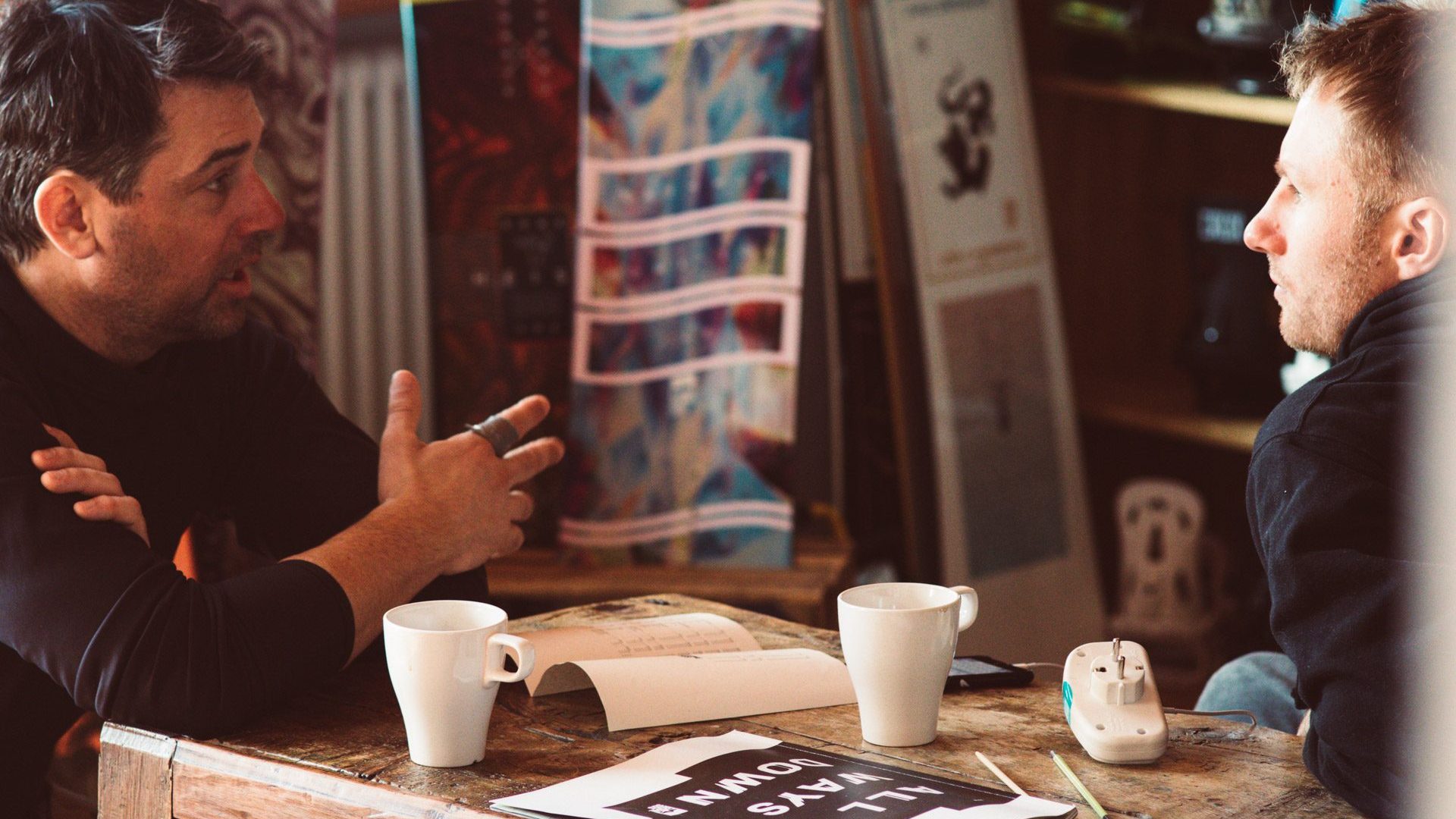
Interview time – Rome’s Josh & SOURCE’s HMT. Photo Tom Greenhill




